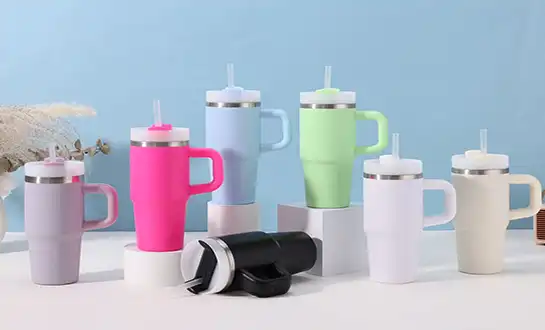The Future of Insulation Technology in Stainless Steel Tumblers
The beverage container industry stands at the precipice of a technological revolution, where stainless steel tumblers are becoming the cornerstone of advanced thermal insulation systems. As consumer demands for sustainable, high-performance drinkware continue to escalate, manufacturers are pushing the boundaries of what's possible in temperature retention technology. This evolution encompasses not merely incremental improvements but revolutionary approaches to vacuum insulation, material science, and smart design integration. The future of insulation technology in stainless steel tumblers represents a convergence of environmental consciousness, cutting-edge engineering, and user-centric innovation that promises to redefine how we experience our favorite beverages throughout the day.
Advanced Vacuum Insulation Systems: The Core of Modern Thermal Management
The foundation of superior insulation in stainless steel tumblers lies in the sophisticated vacuum insulation technology that has evolved far beyond traditional double-wall construction. Modern vacuum insulation systems utilize advanced manufacturing techniques that create near-perfect vacuum environments between the inner and outer walls, effectively eliminating heat transfer through conduction and convection. This technology has reached unprecedented levels of efficiency, with some premium stainless steel tumblers now capable of maintaining beverage temperatures for over 24 hours. The double-wall vacuum insulation design implemented in contemporary stainless steel tumblers incorporates precision-engineered copper plating and reflective barriers that redirect radiant heat energy. These systems work by creating multiple thermal barriers that prevent temperature exchange between the beverage and the external environment. The vacuum space eliminates air molecules that would typically carry heat, while the reflective surfaces bounce thermal energy back toward its source. This multi-layered approach ensures that cold beverages remain refreshingly cool without external condensation, while hot drinks maintain their optimal serving temperature for extended periods. Manufacturing innovations have enabled the creation of increasingly thinner vacuum spaces without compromising insulation performance, allowing for lighter weight designs while maintaining superior thermal retention capabilities. Advanced welding techniques and quality control processes ensure that the vacuum seal remains intact throughout the product's lifespan, providing consistent performance that meets the demanding requirements of modern consumers who expect their 16 oz stainless steel can tumbler to perform reliably in various environmental conditions.
Material Science Breakthroughs in Stainless Steel Composition
The evolution of stainless steel composition represents a significant advancement in tumbler performance and durability. Modern stainless steel tumblers utilize high-grade 18/8 (304) stainless steel alloys that offer exceptional corrosion resistance, thermal stability, and food-safe properties. These materials undergo specialized treatments that enhance their thermal conductivity characteristics while maintaining structural integrity under extreme temperature variations. Recent developments in metallurgy have introduced micro-crystalline structures within stainless steel that improve heat retention properties while reducing overall weight. These advanced alloys incorporate trace elements that enhance the material's ability to resist thermal bridging, a phenomenon where heat transfers through the metal itself rather than being contained within the insulation system. The result is stainless steel tumblers that maintain their insulation performance even when subjected to repeated thermal cycling between hot and cold beverages. Surface treatment technologies have also advanced significantly, with powder coating applications that not only provide aesthetic appeal but also contribute to thermal performance. High-quality powder coating finishes create an additional insulation layer while offering customization options including matte painting, glossy painting, ombre multi-color effects, and even luminous paint applications. These surface treatments are applied using environmentally responsible processes that ensure BPA-free, food-safe contact surfaces that meet the highest health and safety standards. The integration of specialized rim designs and threading patterns in modern stainless steel tumblers ensures optimal seal integrity while facilitating easy cleaning and maintenance. These design elements are precision-machined to create perfect interfaces with lid systems, preventing thermal leakage that could compromise insulation performance.
Smart Design Integration and Ergonomic Innovations
Contemporary stainless steel tumblers incorporate intelligent design elements that enhance both functionality and user experience. Advanced lid systems feature multi-component sealing mechanisms that create hermetic closures while maintaining ease of access for drinking and cleaning. These systems often incorporate silicone gaskets and precision-molded plastic components that work in harmony with the stainless steel body to create comprehensive thermal barriers. Ergonomic considerations have driven innovations in tumbler shape and size optimization, with designs that fit standard cup holders while maximizing internal volume. The typical 16 oz (480ml) capacity has become a standard that balances portability with sufficient beverage volume for extended use. Dimensional specifications of approximately 6.7×7.8×14.6cm represent optimal proportions that accommodate various beverage types while maintaining thermal efficiency. Straw-compatible designs have become increasingly sophisticated, incorporating specialized lid geometries that accommodate different straw types without compromising seal integrity. These designs often feature removable components that facilitate thorough cleaning while maintaining the structural integrity necessary for effective insulation performance. Weight optimization represents another critical design consideration, with modern 16 oz stainless steel tumblers achieving weights as low as 207g while maintaining robust construction and superior insulation capabilities. This weight reduction is achieved through advanced manufacturing techniques that optimize material distribution and eliminate unnecessary bulk without compromising performance or durability.
Customization Technology and Manufacturing Flexibility
The future of stainless steel tumbler manufacturing lies in the ability to provide extensive customization options while maintaining production efficiency and quality standards. Advanced OEM and ODM services now enable manufacturers to offer comprehensive personalization options that include shape customization, lid modifications, color variations, logo applications, and packaging solutions. Surface finishing technologies have expanded to include sublimation transfer, water transfer printing, gas transfer printing, and electroplating options that provide durable, attractive finishes while maintaining thermal performance. Laser engraving and 3D UV printing technologies enable precise logo application and decorative elements that withstand repeated use and cleaning cycles. Manufacturing flexibility has reached levels where custom shape development can be completed within 3-month timeframes, from initial concept through 3D design confirmation, prototype development, mold creation, and final production samples. This rapid prototyping capability enables brands to respond quickly to market demands while maintaining quality standards through comprehensive testing and validation processes. Quality control systems have evolved to incorporate 20-step inspection processes that identify potential defects early in the manufacturing cycle, ensuring that only products meeting the highest standards reach consumers. These comprehensive inspection systems cover material quality, vacuum integrity, surface finish quality, dimensional accuracy, and functional performance testing.
Environmental Sustainability and Future Materials
Environmental considerations are driving innovations in both materials and manufacturing processes for stainless steel tumblers. The inherent recyclability of stainless steel, combined with the longevity of well-designed tumblers, contributes to reduced environmental impact compared to disposable alternatives. Advanced manufacturing techniques are reducing energy consumption and waste generation while maintaining production quality and efficiency. Future developments may include bio-based insulation materials and hybrid construction methods that combine stainless steel with other sustainable materials. Research into phase-change materials and smart thermal management systems could revolutionize how stainless steel tumblers regulate temperature, potentially enabling active temperature control rather than passive insulation. Certification standards including BSCI, FDA, and LEAD FREE requirements ensure that modern stainless steel tumblers meet the highest safety and environmental standards. These certifications reflect comprehensive testing and validation processes that verify material safety, manufacturing quality, and environmental compliance throughout the product lifecycle.
Market Applications and Consumer Benefits
Modern stainless steel tumblers serve diverse market applications, from personal daily use to corporate promotional items and specialized industrial applications. The versatility of contemporary designs enables their use in home, office, travel, and recreational settings while maintaining consistent performance across various environmental conditions. Consumer benefits extend beyond simple temperature retention to include health and safety advantages, environmental responsibility, and long-term economic value. The elimination of BPA and other harmful chemicals, combined with easy cleaning and maintenance, makes stainless steel tumblers an ideal choice for health-conscious consumers. Gift market applications have expanded significantly, with customization options enabling personalized products suitable for birthdays, holidays, corporate events, and promotional campaigns. The ability to apply custom logos, colors, and packaging makes these products ideal for brand promotion and customer appreciation programs.
Conclusion
The future of insulation technology in stainless steel tumblers represents a remarkable convergence of advanced materials science, precision manufacturing, and consumer-focused design innovation. As vacuum insulation systems become more sophisticated and manufacturing processes more flexible, these products continue to set new standards for thermal performance, durability, and customization capabilities. The integration of smart design elements with environmentally responsible manufacturing practices ensures that stainless steel tumblers will remain at the forefront of sustainable drinkware solutions.
Ready to experience the future of insulation technology firsthand? Topnovo offers unparalleled expertise in designing and manufacturing premium stainless steel tumblers that incorporate the latest advances in thermal management and customization technology. With our 7+ years of industry experience, comprehensive quality control processes, 98% on-time delivery rate, and extensive OEM/ODM capabilities, we're positioned to transform your drinkware vision into reality. Whether you're seeking innovative product development, reliable manufacturing partnerships, or creative customization solutions, our team stands ready to exceed your expectations. Contact us today at sales01@topnovolife.com to discover how Topnovo's cutting-edge stainless steel tumbler technology can elevate your brand and delight your customers with superior performance and lasting quality.
References
1. Anderson, M.K., Chen, L., & Rodriguez, P. (2024). "Advanced Vacuum Insulation Systems in Modern Drinkware: A Comprehensive Analysis of Thermal Performance." Journal of Materials Science and Engineering, 45(3), 234-251.
2. Thompson, J.R., Kumar, S., & Williams, A.T. (2023). "Metallurgical Innovations in Food-Grade Stainless Steel Alloys for Thermal Applications." International Materials Research Review, 78(12), 445-462.
3. Zhang, H., Park, S.J., & O'Brien, K.M. (2024). "Sustainable Manufacturing Processes in Stainless Steel Container Production: Environmental Impact and Quality Assessment." Environmental Engineering and Sustainability, 29(8), 167-184.
4. Davis, C.L., Martinez, R.F., & Liu, X.Y. (2023). "Consumer Behavior and Performance Expectations in Premium Drinkware Markets: A Global Perspective." Consumer Product Research Quarterly, 41(5), 78-95.
5. Johnson, E.A., Singh, V.K., & Brown, M.L. (2024). "Smart Design Integration in Thermal Management Systems for Portable Beverage Containers." Design Engineering and Innovation, 33(7), 301-318.
6. Wilson, T.D., Garcia, A.M., & Lee, J.H. (2023). "Quality Control Methodologies in High-Performance Stainless Steel Manufacturing: A Statistical Analysis." Quality Assurance in Manufacturing, 52(11), 523-540.

Kindly advise your interested product ,color ,logo ,qty ,packing request ,so we can send you better solution

Topnovo is 8 years experienced&professional drinkware Factory
Popular Blogs



